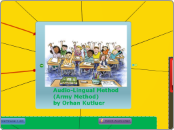
Audio-Lingual Method (Army Method)
by Orhan Kutluer

Students Role
Have just a little bit control over the lessons, context and pace of learning
Repeating the teacher.
Obey the rules
Ss are passive during the learning.

The Principles
Only the target language is used.
Choral Repetition
Bacward build-up Drill is used.
Chain Driil is used.
Students should overlearn
Grammar is not learned, but acquired.
Language Leanring is in habit form.

Historical Background and Some Differences among the Methods
The Audio-Lingual method of teaching had its origins during World War II when it became known as the Army method.
It is also called the Aural oral approach. It is based on the structural view of language and the behaviorist theory of language learning.
The audiolingual approach to language teaching has a lot of similarities with the direct method.
Both were considered as a reaction against the shortcomings of the Grammar Translation method, both reject the use of the mother tongue and both stress that speaking and listening competences preceded reading and writing competences.
But there are also some differences. The direct method highlighted the teaching of vocabulary while the audiolingual approach focus on grammar drills
Disadvantages
Too Rigid
Classes tend to Drag
It's not contextualized
It's time-consuming
Ignores the writing and reading skills
Parroting (Repeating) is not good about creativity

Teacher's Roles
Teacher is a model
Controller of the learning
Keep students awake and make them attend to lesson
Teacher monitors students performance

The Techniques
Dialog Memorization
Grammar Games
Minimal Pairs
Driils
Question and Answer Driil
Single/Multiple-slot substitution Drill
Repetition Drill
Backward build-up Drill
Transformation Drill
Repetition
Completing Dialogs
Contextual Referances
Developed during World War II. in USA
Based on the Behavioral Psychology
Positive/Negative reinforcement develop incorrect habits

Advantages
Subtopic
Correct Behavioral Patterns
Fluent adn Correct Language
Advanced Listening and Speaking
Communicative Language is acquired.
It aims at developing listening and speaking skills which is a step away from the Grammar translation method
